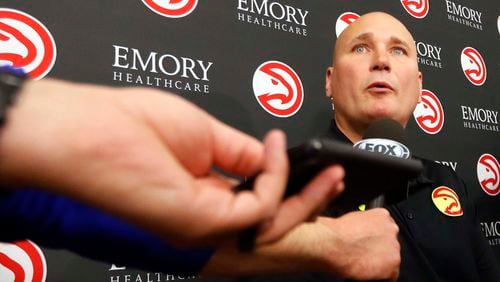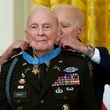Hawks general manager Travis Schlenk often refers to picks in the NBA draft as “swings of the bat.” He wants as many as possible to increase his chances of hitting on a superstar talent who can help lift the Hawks to championship contention.
The Hawks are still in the early stages of executing Schlenk’s plan. But during Thursday night’s draft, Schlenk will be under more pressure than ever to hit a home run.
“This is the biggest pick that I’ve been a part of,” Schlenk said.
Last year, Schlenk’s first as Hawks GM, he used the No. 19 pick on John Collins, who had a very good rookie season. The expectations are much higher in his second Hawks draft because the team owns the No. 3 overall pick. Even if Schlenk trades down in the order — the Hawks are entertaining offers for the No. 3 pick — Schlenk will be scrutinized both for that move and the player he ends up drafting wherever he picks.
During Schlenk’s seven years as an executive in Golden State’s front office, the Warriors never picked higher than sixth. That No. 6 pick was used in the 2010 draft on Baylor forward Ekpe Odoh, who was out of the league by 2015 and played two seasons in Europe before returning to the NBA to play for the Jazz last season.
Draft mistakes like Udoh happen, which is why Schlenk favors accumulating multiple picks. The Hawks have three other picks in this draft: Nos. 19, 30 and 34 overall. They also own the rights to Cleveland’s pick if it isn’t among the top 10 in the 2019 or 2020 drafts.
But mistakes have happened less often with the No. 3 pick, which means there is a higher expectation for Schlenk to get it right. If the Hawks use that pick on a player who doesn’t become a star, it’s uncertain when or if they will pick that high again. If past drafts are an indication, Schlenk should be able to get a good player with the No. 3 pick in this draft.
Ben Falk was a basketball analytics manager with the Blazers and then Sixers VP of basketball strategy before creating Cleaning the Glass, a web site that includes advanced NBA statistics and in-depth articles. Falk said that, historically, the No. 3 pick has developed into an all-star level player about 60 percent of the time and a starter or high-level backup about 30 percent of the time.
“Now, that's obviously dependent on the talent in each draft,” Falk said in an email. “We'd have to lower our expectations for a draft with less talent. This draft seems like it has a number of good options in this range, which means we'd be very surprised if the pick does not end up as a solid rotation player at the very least and is likely to end up as a very high-level player.”
The No. 3 overall pick will be the first tangible asset used by Schlenk during his rebuilding plan — or, as he prefers to call it, “investing in the future.”
The Hawks won the third pick in the draft lottery after they finished last season with the second-worst record (24-58) since the franchise moved to Atlanta before the 1968-69 season. A season near the bottom of the NBA standings was expected after Schlenk made a series of moves that cleared salary-cap space, replaced outgoing veterans with lesser talent and added several prospects to the roster.
Before last season the Hawks had qualified for the playoffs for 10 straight seasons but advanced as far as the conference finals just once. Hawks principal owner Tony Ressler decided that, to be true contenders, the team needed to rebuild the roster via the draft.
Ressler hired Schlenk to execute that strategy, which inevitably meant the Hawks would be a bad team last season. The Hawks figure to be near the bottom of the standings again next season and perhaps in 2019-20, too.
Their hope is that eventually some of the players they draft will form the core of a team good enough to compete for NBA championships.
“I hope it’s fast, but I don’t necessarily think it will be,” Schlenk said. “I will say that (compared to) when I started in the front office in Golden State, we are in a much better place with our salary-cap structure and the picks we have acquired. I’ve said all along the draft is not an exact process. It takes a little luck.”
The potential to be very unlucky in the draft is one risk with Schlenk’s strategy. There’s also potential downsides for teams that lose lots of games, including a negative organizational culture that can hurt the development of the young players.
But part of Ressler and Schlenk’s rationale for focusing on the draft to build the roster is that top free agents haven’t signed with the Hawks over the years. Marquee franchises like the Celtics and Lakers usually can count on having a good chance to sign the best free agents. The Hawks decided that the draft is the best path for them to add star talent to their roster.
One big advantage with drafting players is that the salaries of first-round picks are limited by the rookie scale for up to four seasons. If they become good NBA players they will be earning below-market salaries, which frees up cap space for adding veterans. A team that drafts a player also has the right to match any contract they receive as restricted free agents after four years, and can pay the player significantly more as an unrestricted free agent after five seasons.
Ideally, that five-year window is when a drafted prospect blossoms into a star. If a team can do it more than once over two or three years, it can build the foundation for a championship team while maintaining the cap space to add complementary free agents.
That’s the general idea behind “The Process,” the nickname the Sixers adopted for their plan of shedding the roster of pricey talent, losing lots of games and accumulating as many high draft picks as possible. Starting in 2013-14, the Sixers won 19, 18, 10 and 28 games over four seasons.
The Sixers were widely criticized for the practice. They quieted critics somewhat by advancing to the 2018 East semifinals with a team that included young stars Ben Simmons (No. 1 overall pick in the 2015 draft) and Joel Embiid (No. 3 in 2014).
Falk worked for Philadelphia’s front office during the “Process” era. He said whether such a plan is worth it “depends on the goals of a franchise and what price they're willing to pay to increase their championship odds.” Not every franchise owner is willing to take the immediate public relations and financial hits associated with losing lots of games for the chance to draft prospects who may not pan out.
“It is certainly the case that building through the draft is a viable strategy,” Falk said. “It is not one without risk, but the mentality to get many swings of the bat is one grounded in the history of the draft.”
The Sixers needed several swings to collect hits. It remains to be seen if their long-term plan will result in a team that is a true championship contender.
Simmons and Embiid look like they'll be All-Star players for multiple years. But Markelle Fultz, the No. 1 pick in 2017, has an uncertain future after his rookie season was derailed bu mysterious shoulder injury that reportedly may actually be a mental block. Jahlil Okafor, the No. 3 pick in 2015, was traded to the Nets in December after two-plus disappointing seasons in Philadelphia.
The Hawks are just beginning their own rebuilding process. Schlenk will take his first big swing in the draft for the Hawks on Thursday.
“We are in a situation where we are looking to add the most talent we can, and we are going to get a good player with the third pick,” Schlenk said.







